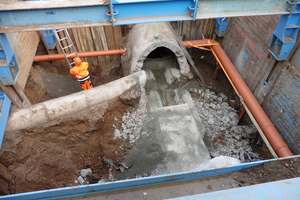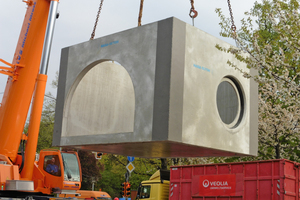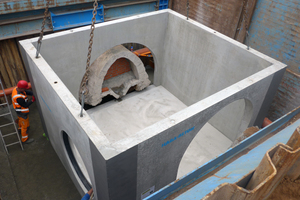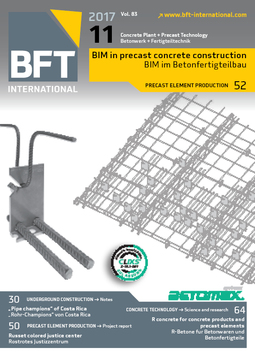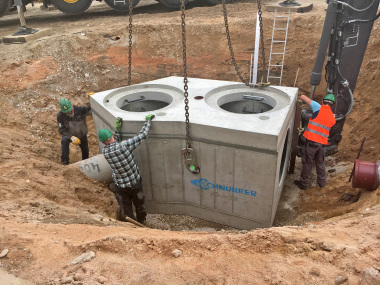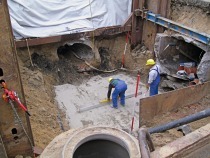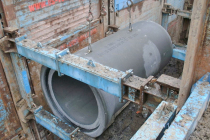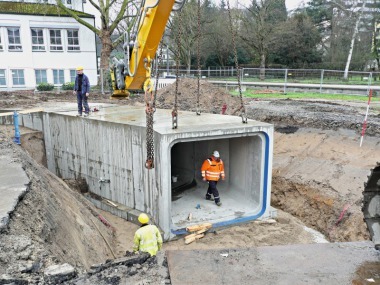Municipal sewer system with specialized structures in FBS quality
In March 2017, the Stadtentwässerung Dresden GmbH sewer authorities of the German city of Dresden, Germany, completed another large-scale sewerage project. Within the scope of the major urban railway project Stadtbahn Dresden 2020, which includes erection of a streetcar route, the sewer system along Franz Liszt and Tiergarten Streets was completely replaced and the hydraulic systems considerably extended over a length of 330 m. For this project, many different and enlarged pipe cross-sections were used (in particular circular ND 1200 cross-sections and/or ND 600/900 oval cross sections). In selecting the material for reconstruction of the underground infrastructure, the planners placed especially strict requirements on the quality of the special separation and combining structures.
The particularity of this construction measure consists of connection of the rehabilitated sewers to the inlets and outlets of the existing sewerage system by means of structures with special properties.
“One example here is connection of the new, larger reinforced-concrete sewers with dry-weather flume of ND 1200 from Franz Liszt Street to the combined sewer in Tiergarten Street by means of a new combining structure 3.60 m long, 4.00 m wide, and 2.70 m high. This structure combines two inlets into one outlet,” explained Anke Bergander of the consulting company IBK Dresden GmbH.
Pipe connections on four sides
The structure is dimensioned to favor the hydraulic characteristics of the inflowing sewage from Franz Liszt Street into the sewage flow on Tiergarten Street. The manhole is located in the corner between inlet ND 1200 and the outlet. For cleaning, an opening of ND 600 has been positioned above the main channel in the middle of the structure.
Another combining structure is of pentagonal shape, 2.50 m long, 1.90 m wide and 3.00 m high, which replaces an old manhole on the corner of Lockwitzer Street and Heinrich Zille Street. It combines two inlets into one outlet. A third special structure of 1.60 m length, 1.00 m width, and 3.00 m height replaces an old manhole at the intersection of Oskar Street and Wiener Street. It has been fitted with pipe connections on four sides – two inlets and two outlets – one of which is positioned 18 cm above the other and enables balancing of the network. This structure thus serves both for combining and separating the outflowing sewage.
Manhole lining based on angular connection
The structures for the project were manufactured in accordance with Code of Practice 2-2, “Manholes Made of Reinforcement Concrete Components in FBS Quality for Underground Pipes and Sewers,” as published by the trade association Fachvereinigung Betonrohre und Stahlbetonrohre (FBS).
“The concrete is highly resistant to sulfate, with great resistance to water penetration in a moderately aggressive chemical environment, in accordance with DIN EN 206 and DIN 1045-2, and with compressive strength class C40/50, WU, WF, using an SR cement in exposure class XA2,” explained Christian Kick from the company Haba-Beton in the city Garching an der Alz, Germany, which supplied the structures and the reinforced-concrete pipes for construction stage 1.4, “Base and cover slab for every component part were made of one piece. Delivery took place by special transport,” said Kick.
For pipe connection ND 1200, the manufacturer built a manhole lining based on the planned connecting angle – slightly inclined on the wall of the structure – thereby eliminating the need for fashioning a rough opening.
Third-party inspection every six months
Manufacture of the structures used, as based on the Quality Guideline of Fachvereinigung Betonrohre und Stahlbetonrohre (FBS), moreover, gave the planners the assurance that tested quality is built into the project. “The FBS Codes Of Practice include comprehensive factory-production control and ensure continuous quality supervision, beginning with the constituent materials for manufacture and ending with the final products,” says Kick. “In addition, out-of-house control every six months by notified bodies and approved testing institutes ensure adherence to the high standards.” And Anke Bergander adds: “Of significance to us are most of all the good properties of the products of FBS quality used here, with regard to tightness, loadbearing capacity, and hydraulics.”

